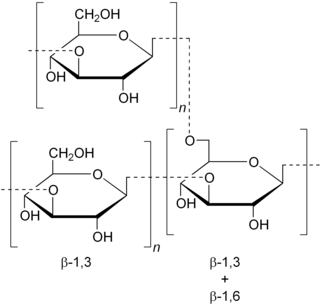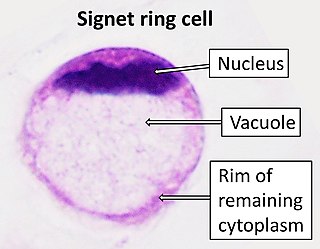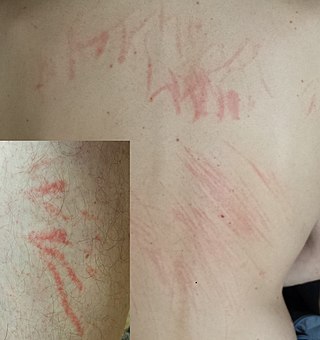
The shiitake is an edible mushroom native to East Asia, which is cultivated and consumed around the globe. It is considered a medicinal mushroom in some forms of traditional medicine.

Schizophyllan is a neutral extracellular polysaccharide produced by the fungus Schizophyllum commune. Schizophyllan is a β-1,3 beta-glucan with β-1,6 branching. Schizophyllan is also known as sizofiran.

Sorafenib, sold under the brand name Nexavar, is a kinase inhibitor drug approved for the treatment of primary kidney cancer, advanced primary liver cancer, FLT3-ITD positive AML and radioactive iodine resistant advanced thyroid carcinoma.
A glucan is a polysaccharide derived from D-glucose, linked by glycosidic bonds. Glucans are noted in two forms: alpha glucans and beta glucans. Many beta-glucans are medically important. They represent a drug target for antifungal medications of the echinocandin class.

Enprostil is a synthetic prostaglandin designed to resemble dinoprostone. Enprostil was found to be a highly potent inhibitor of gastric HCl secretion. It is an analog of prostaglandin E2 but unlike this prostaglandin, which binds to and activates all four cellular receptors viz., EP1, EP2, EP3, and EP4 receptors, enprostil is a more selective receptor agonist in that it binds to and activates primarily the EP3 receptor. Consequently, enprostil is expected to have a narrower range of actions that may avoid some of the unwanted side-effects and toxicities of prostaglandin E2. A prospective multicenter randomized controlled trial conducted in Japan found combining enprostil with cimetidine was more effective than cimetidine alone in treating gastric ulcer.

Beta-glucans, β-glucans comprise a group of β-D-glucose polysaccharides (glucans) naturally occurring in the cell walls of cereals, bacteria, and fungi, with significantly differing physicochemical properties dependent on source. Typically, β-glucans form a linear backbone with 1–3 β-glycosidic bonds but vary with respect to molecular mass, solubility, viscosity, branching structure, and gelation properties, causing diverse physiological effects in animals.

AHCC is an alpha-glucan rich nutritional supplement produced from shiitake. The product is a subject of research as a potential anti-cancer agent. AHCC is a popular alternative medicine in Japan.

Metopimazine, sold under the brand names Vogalen and Vogalene, is an antiemetic of the phenothiazine group which is used to treat nausea and vomiting. It is marketed in Europe, Canada, and South America. As of August 2020, metopimazine has been repurposed and is additionally under development for use in the United States for the treatment of gastroparesis.
1,3-Beta-glucan synthase is a glucosyltransferase enzyme involved in the generation of beta-glucan in fungi. It serves as a pharmacological target for antifungal drugs such as caspofungin, anidulafungin, and micafungin, deemed 1,3-Beta-glucan synthase inhibitors. Under the CAZy classification system, fungi and plant members fall in the glycosyltransferase 48 family (GT48). Some members of the glycosyltransferase 2 family, such as the curdlan synthase CrdS, also has a similar activity.
Tegafur/uracil is a chemotherapy drug combination used in the treatment of cancer, primarily bowel cancer. It is also called UFT or UFUR.

Signet ring cell carcinoma (SRCC) is a rare form of highly malignant adenocarcinoma that produces mucin. It is an epithelial malignancy characterized by the histologic appearance of signet ring cells.
Helicobacter pylori eradication protocols is a standard name for all treatment protocols for peptic ulcers and gastritis in the presence of Helicobacter pylori infection. The primary goal of the treatment is not only temporary relief of symptoms but also total elimination of H. pylori infection. Patients with active duodenal or gastric ulcers and those with a prior ulcer history should be tested for H. pylori. Appropriate therapy should be given for eradication. Patients with MALT lymphoma should also be tested and treated for H. pylori since eradication of this infection can induce remission in many patients when the tumor is limited to the stomach. Several consensus conferences, including the Maastricht Consensus Report, recommend testing and treating several other groups of patients but there is limited evidence of benefit. This includes patients diagnosed with gastric adenocarcinoma, patients found to have atrophic gastritis or intestinal metaplasia, as well as first-degree relatives of patients with gastric adenocarcinoma since the relatives themselves are at increased risk of gastric cancer partly due to the intrafamilial transmission of H. pylori. To date, it remains controversial whether to test and treat all patients with functional dyspepsia, gastroesophageal reflux disease, or other non-GI disorders as well as asymptomatic individuals.

Itopride (INN; brand name Ganaton) is a prokinetic benzamide derivative. These drugs inhibit dopamine and acetylcholine esterase enzyme and have a gastrokinetic effect. Itopride is indicated for the treatment of functional dyspepsia and other gastrointestinal conditions. It is a combined D2 receptor antagonist and acetylcholinesterase inhibitor.

Pleurotus pulmonarius, commonly known as the Indian oyster, Italian oyster, phoenix mushroom, or the lung oyster, is a mushroom very similar to Pleurotus ostreatus, the pearl oyster, but with a few noticeable differences. The caps of pulmonarius are much paler and smaller than ostreatus and develops more of a stem. P. pulmonarius also prefers warmer weather than ostreatus and will appear later in the summer. Otherwise, the taste and cultivation of the two species is generally described as largely the same. Another similar species, North America's Pleurotus populinus, is restricted to growing on aspen and cottonwood.

Polysaccharide-K is a protein-bound polysaccharide isolated from the mycelium of Trametes versicolor.

Shiitake mushroom dermatitis is an intensely itchy dermatitis characterized by disseminated 1mm erythematous micropapules seen in a linear grouped arrangement secondary to Koebnerization due to patient scratching. It is caused by the ingestion of shiitake mushrooms and was first described in 1977 by Nakamura. Although it is rarely seen outside China and Japan due to a lower incidence of shiitake consumption outside these regions, there is a well-established association between flagellate dermatitis and shiitake mushroom ingestion. Bleomycin ingestion may also cause similar findings. On physical exam, one key difference between the two is that post-inflammatory hyperpigmentation changes are usually seen with bleomycin-induced flagellate dermatitis and are not typically present with shiitake mushroom induced flagellate dermatitis. The median time of onset from ingestion of shiitake mushrooms is typically 24 hours, ranging from 12 hours to 5 days. Most patients completely recover by 3 weeks, with or without treatment. Although the pathogenesis of shiitake induced flagellate dermatitis is not clear, the theory most argued for is a toxic reaction to lentinan, a polysaccharide isolated from shiitake mushrooms. However, Type I and Type IV allergic hypersensitivities have also been supported by the 24-hour median time of onset, clearance in 3–21 days, severe pruritus, benefit of steroids and antihistamines, and lack of grouped outbreaks in people exposed to shared meals containing shiitake mushrooms. Most cases reported shortly after its discovery were due to consumption of raw shiitake mushrooms, but several cases have since been reported after consumption of fully cooked mushrooms.

Motesanib is an experimental drug candidate originally developed by Amgen but later investigated by the Takeda Pharmaceutical Company. It is an orally administered small molecule belonging to angiokinase inhibitor class which acts as an antagonist of VEGF receptors, platelet-derived growth factor receptors, and stem cell factor receptors. It is used as the phosphate salt motesanib diphosphate. After clinical trials in thyroid cancer, non-small cell lung cancer, gastrointestinal stromal cancer, colorectal cancer, and breast cancer, the drug was not found to show sufficient efficacy for further development, and development was abandoned by Takeda.
Medicinal fungi are fungi that contain metabolites or can be induced to produce metabolites through biotechnology to develop prescription drugs. Compounds successfully developed into drugs or under research include antibiotics, anti-cancer drugs, cholesterol and ergosterol synthesis inhibitors, psychotropic drugs, immunosuppressants and fungicides.
Helicobacter heilmannii s.s. is a species within the Helicobacter genus of Gram negative bacteria. Helicobacter pylori is by far the best known Helicobacter species primarily because humans infected with it may develop gastrointestinal tract diseases such as stomach inflammation, stomach ulcers, duodenal ulcers, stomach cancers of the non-lymphoma type, and various subtypes of extranodal marginal zone lymphomass, e.g. those of the stomach, small intestines, large intestines, and rectumn. H. pylori is also associated with the development of bile duct cancer and has been associated with a wide range of other diseases although its role in the development of many of these other diseases requires further study. Humans infected with H. heilmannii s.s. may develop some of the same gastrointestinal diseases viz., stomach inflammation, stomach ulcers, duodenal ulcers, stomach cancers that are not lymphomas, and extranodal marginal B cell lymphomas of the stomach. Other non-H. pylori Helicobacter species that are known to be associated with these gastrointestinal diseases are Helicobacter bizzozeronii, Helicobacter suis, Helicobacter felis, and Helicobacter salomonis. Because of their disease associations, these four Helicobacter species plus H. heilmannii s.s. are often group together and termed Helicobacter heilmannii sensu lato.
Toripalimab, sold under the brand name Loqtorzi, is a monoclonal antibody used for the treatment of melanoma and nasopharyngeal carcinoma. Toripalimab is a recombinant humanized programmed cell death protein 1 (PD-1) monoclonal antibody that acts as a checkpoint inhibitor.













